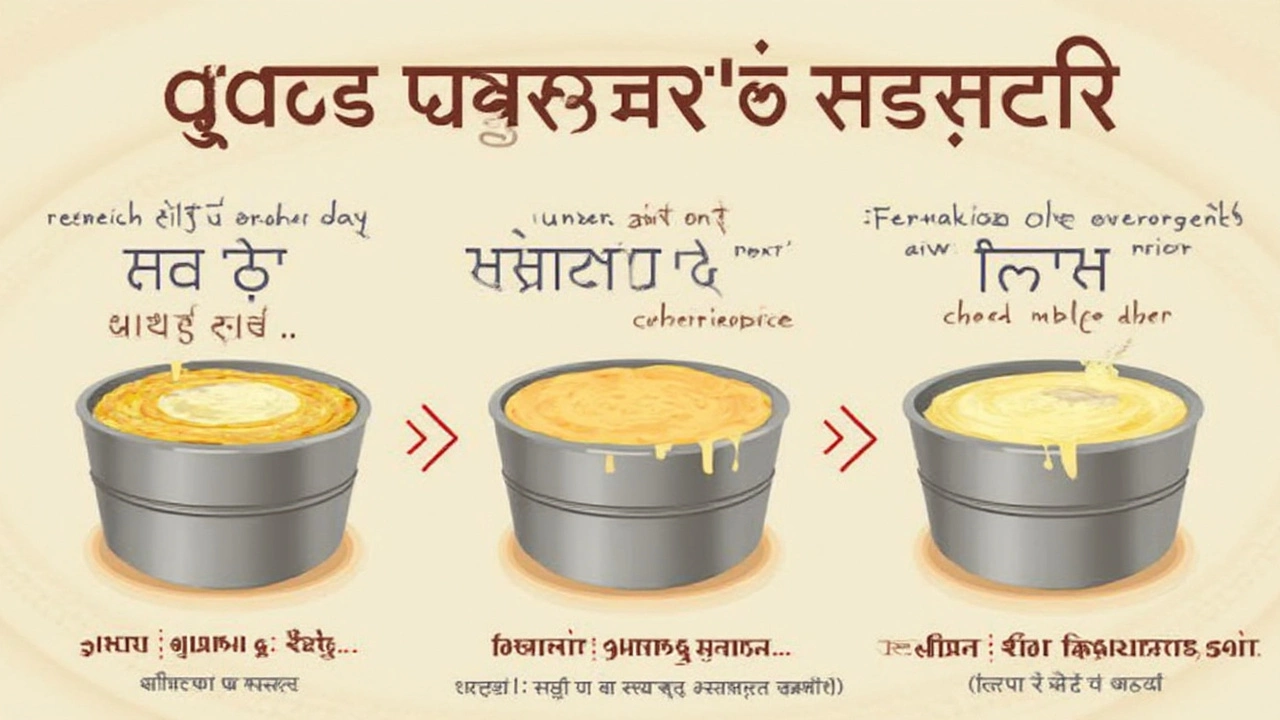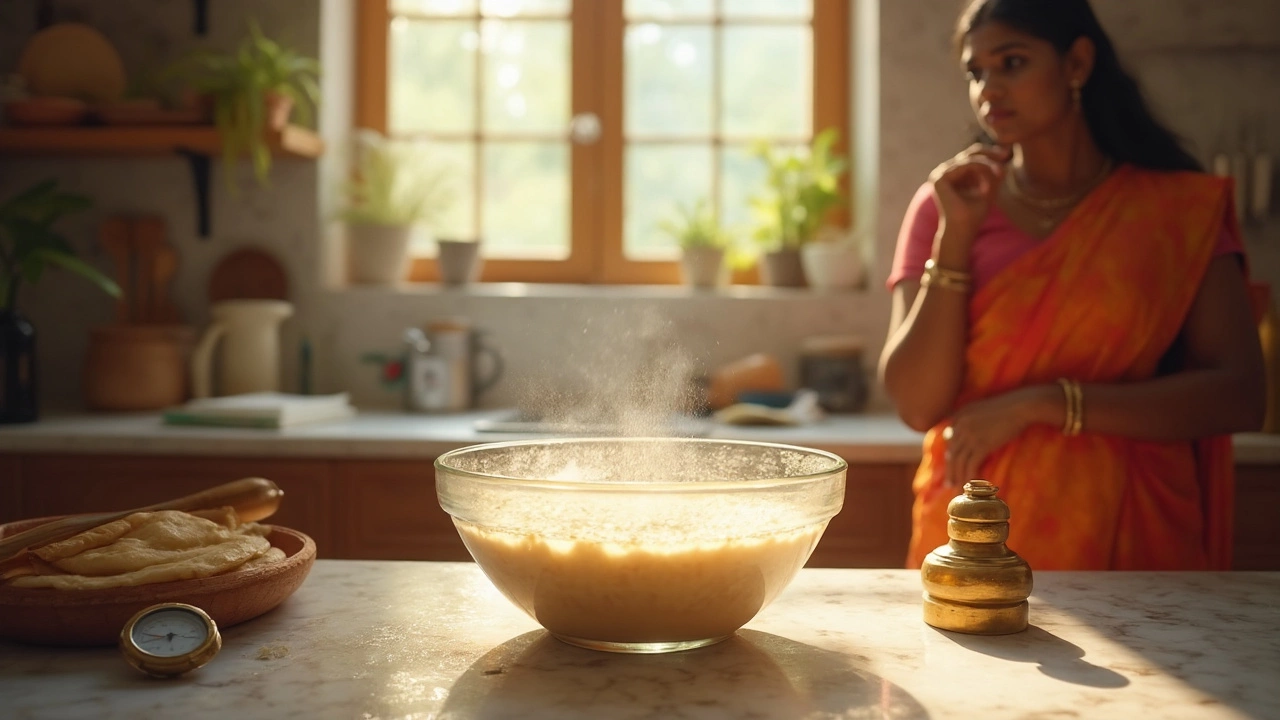Dosa batter acting up and getting sour? You’re definitely not the only one dealing with this. Here’s the thing—dosa batter ferments, just like bread dough or yogurt. That’s how you get those lovely bubbles and that light, crispy texture. But when things go a bit off, suddenly you’re left with a tangy sourness that’s hard to ignore.
So what’s really changing in your kitchen to make batter turn sour? Most of the time, it comes down to how fast the bacteria and wild yeast are having a party in your bowl. These tiny microbes love warmth and time. If the kitchen's a bit warmer, or you leave your batter out longer than planned, you’ll notice the flavor shifts from mild to outright sour.
Use your senses—if your batter smells sharper than your favorite pickle, it’s over-fermented. Taste a tiny bit. If it’s got too much of a tang, you need to change things up fast. But don’t worry, there are smart ways to rescue your batter or at least stop the sourness from happening next time. That’s what we’re diving into, so you never get caught off guard again.
- How Fermentation Causes Sourness
- Big Impact of Temperature and Time
- Fixes for Sour Batter
- Smart Storage and Prevention Tips
How Fermentation Causes Sourness
Fermentation is what turns rice and dal into that classic dosa batter you love, but it’s also what creates sourness. The moment you mix water with ground rice and urad dal, you set off a natural process. Wild yeast and lactic acid bacteria—same sorts you find in yogurt or bread—start feeding on the carbs and sugars in the batter.
As these microbes break things down, they produce bubbles (carbon dioxide) for softness, plus acids that bring out a tangy flavor. It’s those acids—mainly lactic and acetic acids—that make dosa batter taste sour if they build up too much. So, a bit of sourness is normal and actually helps the taste and texture. But once the acid levels go overboard, it’s not so pleasant anymore, and your batter can turn too sharp or even a little funky.
Here’s a quick idea of what’s going on:
- Yeast and bacteria multiply during fermentation—especially in warm conditions.
- They produce acids over time. Longer the batter sits, more acids are pumped out.
- Fermentation speed depends on temperature, the ratio of dal to rice, and even the water you use.
Back in 2022, a group of food scientists found that dosa batter starts to noticeably sour after about 8 to 10 hours at 30°C (86°F). If you leave it out even longer, lactic acid levels get high fast, especially if your kitchen’s hot or you’re using less salt.
So if your dosa batter gets sour often, those wild microbes are working overtime. Knowing how they behave is the first step to keeping your dosas tasting just right—fresh, not funky.
Big Impact of Temperature and Time
Temperature and time decide almost everything when it comes to the sourness of your dosa batter. If it’s hot in your kitchen, the batter ferments way faster. When the room temperature hits above 30°C (86°F), wild yeast and bacteria go into overdrive—sometimes four times as fast as in cooler places. That’s why batter gets sour overnight during summer, but takes almost a whole day in winter.
Leaving batter out for too long is a surefire way to get a tangy surprise in the morning. If you’re going for a mild flavor, eight to twelve hours is usually enough at normal room temp (about 22–25°C or 72–77°F). Any longer or any warmer, you’re letting the microbes have a feast, and the end result: a strong sour taste that’s tough to mask.
| Temperature | Fermentation Time | Batter Flavor |
|---|---|---|
| Above 30°C (86°F) | 6–8 hours | Likely sour |
| 22–25°C (72–77°F) | 8–12 hours | Mild, balanced |
| Below 18°C (64°F) | 16–24 hours | Less sour, even bland |
But don’t forget, temperature isn’t just about the air. Batter inside metal bowls or sitting near a warm oven will ferment quicker than if it’s tucked into a cool corner. That’s why folks in cooler places sometimes even put their dosa batter in the oven (switched off!) with the light on to make sure things get moving. In tropical climates, try placing the batter in the fridge once it’s doubled or starts to smell a bit tangy. That slows things down and buys you more time before the batter goes overboard into sour-town.
So bottom line? Watch your kitchen's temperature and keep an eye on the clock. That’s the simple secret to keeping your batter fresh and tasty, and your dosas just the way you want them.

Fixes for Sour Batter
So, your dosa batter is more sour than you’d like. Don’t toss it yet! There are a few tricks you can try to get things back on track.
First, if the batter is only slightly tangy, just add a handful of fresh rice flour and a splash of water. Stir well. This helps dilute the sourness and brings the fermentation down a notch. For a batch that’s a lot more sour, it’s even better to add a couple spoons of semolina (rava). It absorbs the extra acid so the tang doesn’t overpower your dosas.
- Mix in fresh batter: If you have a little freshly ground, non-fermented batter, mixing it with the old batch is a lifesaver. It cuts the sour hit.
- Rinse with water: Sometimes, giving the batter a gentle rinse with a little water, draining off the top liquid (which is the most sour part), does the trick.
- Make different recipes: Don’t want to risk a weird dosa? Sour batter is perfect for spicier recipes like Paniyaram or Uttapam. These soak up excess flavor and make use of sourness. Just toss in some onions, chilies, and coriander—done!
- Skip fermentation for next batch: If you’re always ending up too sour, try fermenting less next time or pop the batter into the fridge sooner. Cold slows the whole process way down. At around 4°C (your standard fridge), most fermentation stops almost completely after a few hours.
If you’re wondering how sour is too sour, here’s a quick snapshot from a recent kitchen test:
| Fermentation Time (at 28°C) | Taste Level |
|---|---|
| 8 hours | Mild, perfect for classic dosa |
| 12 hours | Noticeable tang, still good for most folks |
| 16 hours+ | Very sour, best for spiced uttapam or paniyaram |
Bottom line: controlling sourness in dosa batter is about keeping a close eye on time and temperature. Make tweaks as soon as you see the batter bubbling up or smell a tang. You'll dodge the sour disaster easily.
Smart Storage and Prevention Tips
Want to keep your dosa batter tasting fresh instead of sour? It mostly comes down to how you store it and a few prevention moves you can easily work into your routine.
The moment your batter has finished fermenting and is nice and bubbly, pop it in the fridge. Chilling slows down the action of those wild bacteria and yeasts, keeping sourness in check. Always use a clean, dry spoon so you’re not introducing more microbes while scooping out your batter.
- Use airtight containers: The less air the batter touches, the fewer wild yeasts or bacteria can sneak in and speed up that sour flavor.
- Divide and conquer: If you’ve prepared a big batch, split it into smaller containers. Take out only what you need. This reduces the number of times you expose the batter to air and warm temps.
- Store on the lowest fridge shelf: Fridge temperatures can vary. Stick to the coldest part (usually the bottom shelf, at the back) to really slow fermentation.
Watch your timing too. Don’t leave dosa batter sitting at room temperature once it’s fermented. Most Indian homes in warm climates notice their batter starts to sour within 8 to 12 hours if left out. If you must store it outside for a few hours, pick a cool, dark spot and cover it tightly.
Here’s a pro tip for the next round: Use slightly less urad dal than rice if your batter turns sour quickly. Urad dal ferments faster and adds tang. You can also add a pinch of salt just before putting the batter in the fridge. Salt slows down those microbes further.
Still dealing with sour batter now and then? It sometimes helps to rinse your rice and dal a couple more times before soaking. You’ll wash away some of the natural wild yeasts that speed up souring.
Check out this quick comparison to see how storage makes a real difference, based on fridge vs. room temperatures at home kitchens:
| Storage | Average Sour Flavor Starts |
|---|---|
| Room temp (25°C-30°C) | 8-12 hours |
| Refrigerated (2°C-4°C) | 3-5 days |
Follow these habits, and you’ll spend a lot less time dealing with sour batter disasters. Your dosas will stay tasty, and you’ll get the most out of each batch.
